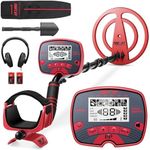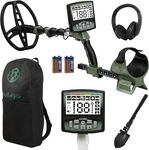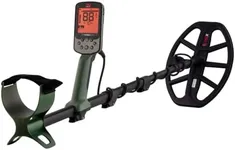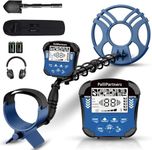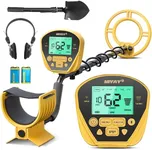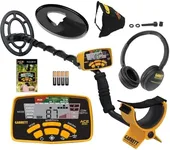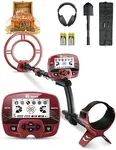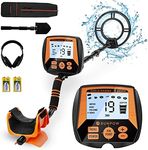Buying Guide for the Best Metal Detectors For Beaches
Choosing the right metal detector for beach use can be a fun and rewarding experience. The key is to understand the different features and specifications that will best suit your needs. Beaches present unique challenges such as saltwater, sand, and varying ground conditions, so it's important to select a metal detector that can handle these environments effectively. Here are some key specifications to consider when picking a metal detector for beach use, along with explanations to help you make an informed decision.Operating FrequencyOperating frequency refers to the number of times a metal detector's coil pulses per second. This is important because different frequencies are better suited for detecting different types of metals. Lower frequencies (1-4 kHz) are better for detecting larger, more conductive metals like silver, while higher frequencies (15-100 kHz) are better for smaller, less conductive metals like gold. For beach use, a mid-range frequency (5-15 kHz) is often ideal as it provides a good balance for detecting a variety of metals in wet and dry sand.
Ground BalanceGround balance is a feature that helps the metal detector distinguish between valuable targets and the minerals in the ground. This is particularly important on beaches where the mineral content can vary greatly, especially in wet sand and saltwater. There are three types of ground balance: preset, manual, and automatic. Preset is the simplest but least flexible, manual allows for fine-tuning, and automatic adjusts on the fly. For beach use, automatic ground balance is often the best choice as it adapts to changing conditions without requiring constant adjustments.
Waterproof CapabilityWaterproof capability indicates whether the metal detector can be submerged in water and to what depth. This is crucial for beach use, especially if you plan to search in shallow water or along the shoreline. Some detectors are only water-resistant, meaning they can handle splashes but not submersion. Fully waterproof detectors can be submerged and are ideal for beach hunting. Consider how deep you plan to search and choose a detector that matches those needs.
DiscriminationDiscrimination is the ability of a metal detector to distinguish between different types of metals. This is important to avoid digging up unwanted items like bottle caps and nails. Detectors with good discrimination settings allow you to filter out junk and focus on valuable targets. Look for a detector with adjustable discrimination settings so you can fine-tune it based on the types of targets you are searching for.
SensitivitySensitivity refers to the metal detector's ability to detect small or deep targets. Higher sensitivity settings can detect smaller or deeper objects but may also pick up more ground noise and false signals. For beach use, it's important to find a balance. Too high sensitivity can make the detector unstable in mineralized sand, while too low sensitivity might miss valuable targets. Adjustable sensitivity settings are ideal so you can adapt to different beach conditions.
Coil Size and TypeThe coil is the part of the metal detector that sends and receives signals. Coil size and type affect the detector's depth and coverage area. Larger coils cover more ground and detect deeper targets but can be less sensitive to small objects. Smaller coils are more precise and better for detecting small items but cover less area. For beach use, a medium-sized coil (8-11 inches) is often a good compromise, providing a balance between depth, sensitivity, and coverage.
Weight and ErgonomicsWeight and ergonomics refer to how comfortable the metal detector is to use over extended periods. Beach hunting can involve a lot of walking and swinging the detector, so it's important to choose one that is lightweight and has a comfortable grip. Adjustable shafts and padded armrests can also enhance comfort. Consider how long you plan to use the detector in one session and choose a model that feels comfortable to you.
